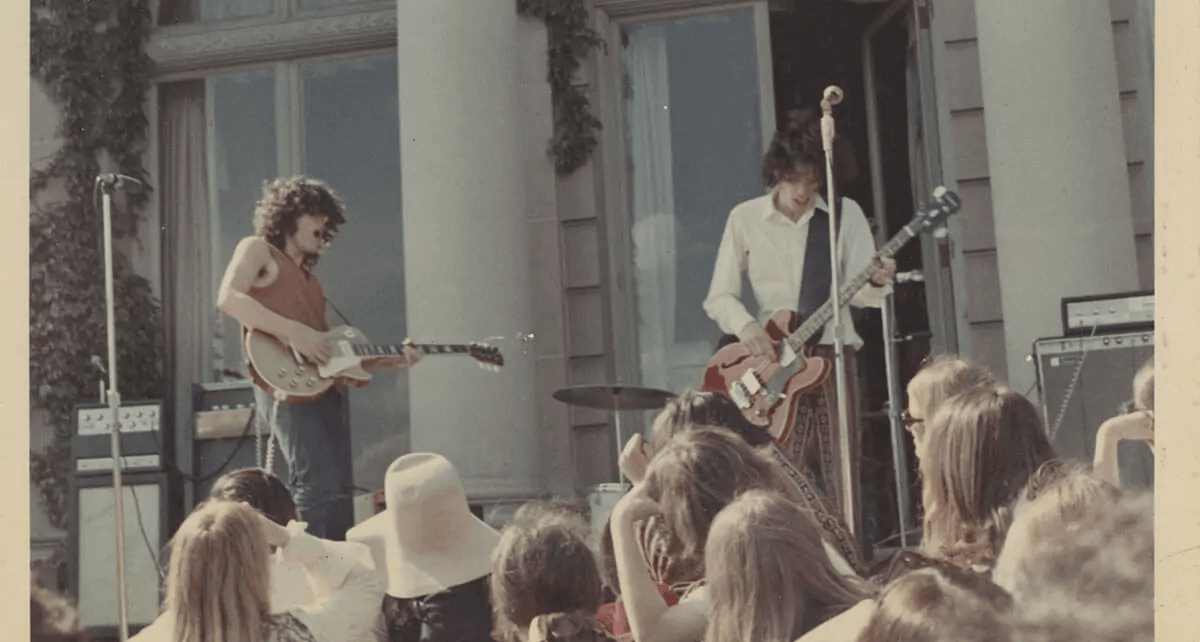Before he became “The Boss,” Bruce Springsteen was a young and ambitious 20-year-old doing what any aspiring rock star would do: playing as much as he could. Springsteen would often play with bands at local venues and colleges to attract his core fanbase—a fanbase that would soon skyrocket from a few thousand students to millions of fans around the world. While he never attended as a student, he would frequent the then-named Monmouth College with his band Child, which would eventually be rechristened as Steel Mill.
His first appearance at the College was with Child at the end of a day-long music festival held on the Great Lawn. Child consisted of drummer Vini “Mad Dog” Lopez, keyboard player Danny “Phantom” Federici, bass player Vinnie Roslin, and was managed by Carl “Tinker” West. According to a past “The Outlook” article about the festival, “Child, the most popular group of the afternoon, produced a wild mind-bending show, which combined the antics and musical talents of the Stones and Iron Butterfly… they literally rocked and blasted out the entire area with their dynamic sound.”
But this concert did not start out so smoothly for the band. When they arrived to set up their gear, the stage seemed to be mobbed by crazed teenagers in a Beatlemania-like scene. The band reportedly saw this, quickly backed away from their instruments, and all ran into Wilson Hall, slamming the doors behind them. It turns out the students were simply trying to get good seats for the top act, and it spooked the band. When it came time for their act, they were cheered on, and attendees were treated to a setlist of Springsteen originals, many of which were never included on any of his albums later down the line. One song in particular, “Resurrection,” seemed to be the fan favorite as it had the entire crowd partying along. The band was such a hit that they were cheered back on for three encores.
“The Wind and the Rain” was another crowd favorite that tended to last almost twenty minutes. It’s gospel-like vocals and long-winded guitar jams emulate Jimi Hendrix and Jan Joplin’s style of music, especially with its heavy guitar, soulful drums, and spiritual organ. “We would go out and just jam for twenty minutes, these were like old jazz songs… if Bruce was going on a lengthy solo, I’d go with him,” Lopez said. Even back then, Springsteen was taking inspiration from the events and places he saw in his everyday life in Freehold and along the Jersey Shore.
The show also resulted in several noise complaints from both Monmouth faculty and houses down Norwood Avenue as far as a quarter mile away. Lopez said, “We were told to turn their music down by someone from the University and after refusing to turn the volume down, this person pulled the cords out of Bruce’s amplifier,” upsetting both the crowd and the band.
Child and Steel Mill became prevailing bands in the scene because before the players came together, they were performing in previously well-known bands from New Jersey. Springsteen came from the Castiles, Stevie Van Zandt came from the Motifs, Federici came from the Storytellers, and Lopez came from Sunny and the Starfires.
Lopez noted that the main reason they stood out among bands at the time was because “we didn’t hide from the people, we were with the people.” They would go out in the crowd to hang out with fans and talk with them before and after shows.
Springsteen would play at Monmouth another eight shows over the course of the next five years. Several of these shows were part of political protests, which fit since the majority of songs played during their shows consisted of anti-war protest songs in response to the Vietnam War. Child’s second performance at the college was during the “1st National Vietnam Moratorium Protest Day” on Oct. 15, 1969, which aimed to end the Vietnam War. The following month, they played an indoor show on the day before the Nov. 15 “Moratorium March on Washington.” After this show, students gathered on rented Washington, D.C.-bound buses for the protest. After being rechristened as Steel Mill, Springsteen and the band played a fundraiser to raise money to bring anti-war speakers to the campus that winter.
On Oct. 17, 1970, 4,000 Steel Mill fans waited for several hours in the pouring rain in hopes of getting the best spot at the sold-out show held in Monmouth’s gymnasium.
Child and Steel Mill’s sound at this time was very different from the style of music associated with Bruce Springsteen and the E Street Band. With these bands being influenced by the likes of The Doors, Led Zeppelin, and King Crimson, the sound of these concerts fell right in line with the experimental music of the late 60s and early 70s. Even to this day, Springsteen is no stranger to Monmouth University as he visits campus and donates his own belongings to his self-titled archives. With the new creation of the Bruce Springsteen Archives & Center for American Music, the “Boss” isn’t going to forget about his roots any time soon.



